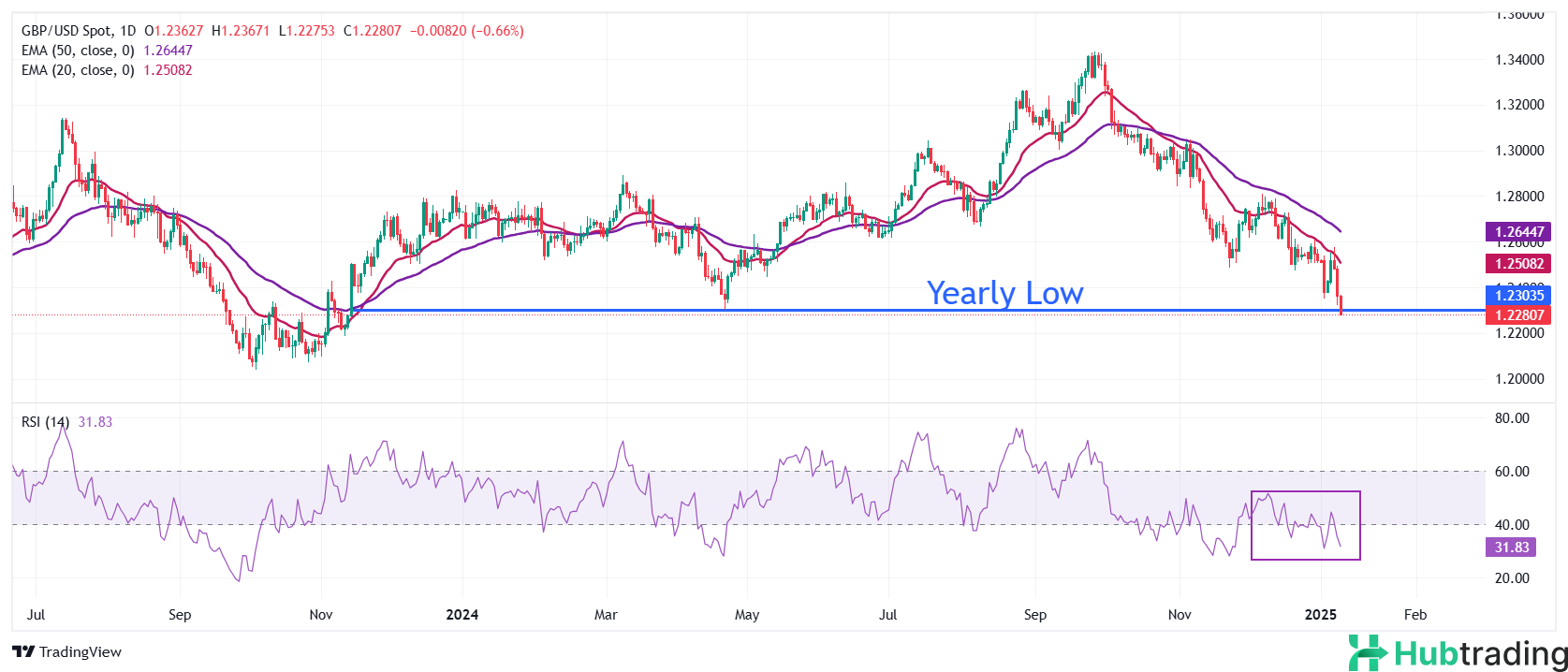- The Pound Sterling experiences significant selling pressure as a sharp rise in UK gilt yields reflects concerns over a fragile economic outlook.
- Persistent UK inflation fears, coupled with Trump’s proposed tariff hikes, have driven UK bond yields to their highest levels since 1998.
- Renewed inflation concerns in the US have prompted Federal Reserve officials to adopt a cautious stance on potential interest rate cuts.
The Pound Sterling (GBP) lagged behind its major counterparts on Thursday, weighed down by a sharp rise in the United Kingdom’s (UK) borrowing costs. A steep sell-off in UK government bonds drove 30-year gilt yields to 5.36%, their highest level since 1998. While rising gilt yields typically enhance the appeal of the British currency, this dynamic has faltered amid mounting inflationary pressures and concerns over potentially inflationary policies from United States (US) President-elect Donald Trump. These factors have cast a shadow over the UK’s economic prospects.
Doubts have emerged over Chancellor of the Exchequer Rachel Reeves' ability to adhere to fiscal rules, particularly the commitment to avoid borrowing for day-to-day expenditures. Addressing these concerns, a British finance ministry spokesperson stated, “No one should be under any doubt that meeting the fiscal rules is non-negotiable, and the government will have an iron grip on the public finances,” as reported by Reuters.
The sharp rise in bond yields has also sparked worries about whether the UK can sustain its funding for public services and growth-focused investments through bond sales without resorting to further tax hikes.
Meanwhile, the Bank of England (BoE) is unlikely to accelerate interest rate cuts, as high inflation—driven by persistent wage growth—continues to pose challenges. Traders are pricing in approximately 60 basis points (bps) of rate reductions from the BoE this year, indicating the possibility of more than two cuts. However, a Goldman Sachs note this week projected that the BoE would implement rate cuts in each quarter of the year, potentially lowering the policy rate to 3.75% by year-end.
Daily Digest Market Movers: Pound Sterling Weakens Against USD Ahead of US NFP
-
The Pound Sterling slid below 1.2300 against the US Dollar (USD) during Thursday’s London session, marking its lowest level in over a year. The GBP/USD pair’s decline comes amid USD strength, bolstered by firm US bond yields and expectations that President-elect Donald Trump may declare a national economic emergency. This declaration would provide legal grounds for a potential increase in import tariffs on both allies and adversaries, according to a CNN report.
-
The US Dollar Index (DXY), which measures the Greenback’s value against six major currencies, inched up to around 109.25 but stayed within Wednesday’s trading range as of writing. Meanwhile, 10-year US Treasury yields hovered near 4.67%, their highest level since April 2024.
-
Market participants anticipate that higher US tariffs could drive demand for domestically produced goods and services, boosting growth prospects, employment, and inflation. Such developments would likely compel Federal Reserve (Fed) policymakers to maintain a cautious stance on interest rates for an extended period, supporting USD strength.
-
Minutes from the Fed’s December meeting revealed that the disinflation process has temporarily stalled, prompting policymakers to signal fewer interest rate cuts for the year.
-
Additionally, the US ISM Services Prices Paid component of the December Purchasing Managers Index (PMI) report surged to 64.4, up sharply from the previous reading of 58.2. This uptick highlights renewed inflationary risks.
-
Looking ahead, investors will closely monitor the US Nonfarm Payrolls (NFP) data for December, set to be released on Friday. This report is expected to provide further insights into the labor market and influence market sentiment.
Technical Analysis: Pound Sterling Hits Over One-Year Low Below 1.2300
The Pound Sterling extended its decline, reaching a more-than-one-year low near 1.2250 against the US Dollar (USD) on Thursday. The GBP/USD pair faced intensified selling pressure after breaching the January 2 low of 1.2350. The broader outlook for the pair remains bearish, with the 20-day and 50-day Exponential Moving Averages (EMAs), positioned around 1.2510 and 1.2645, respectively, continuing to trend downward.
The 14-day Relative Strength Index (RSI) has sharply dropped to approximately 30.00, signaling strong bearish momentum.
On the downside, the pair is likely to find its next support level near the November 10, 2023 low of 1.2185. Conversely, the 20-day EMA will serve as a key resistance level for any potential upside movements.






